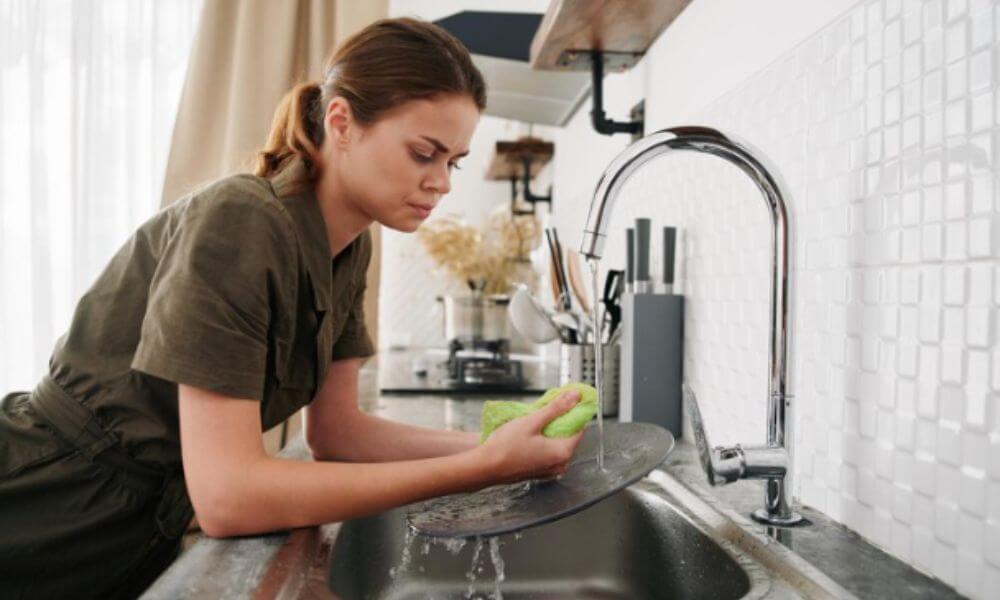How to Clean Kitchen Sink: Keep The Sink Shining


The kitchen sink, an unsung hero of your culinary space, is more than just a workplace for food prep and dishwashing—it’s a hub for germs and food residues that need constant vigilance. Neglecting your kitchen sink’s cleanliness could potentially turn it into a breeding ground for bacteria, affecting the health of your household. This definitive guide will walk you through the best practices and tips to ensure your kitchen sink remains a bastion of cleanliness.
The Pre-Rinse Routine
Before you even start washing the dishes, give the sink a good pre-rinse to remove any loose food particles. Use hot water and a gentle dish soap or a vinegar solution to break down grease.
Choose Your Weapon: Sink Materials and Their Cleaning Codes
Never use abrasive cleaners on the following surfaces:
Stainless Steel: Use a soft scrub brush or nylon mesh pad with a side of Baking Soda.
Porcelain-Enameled Cast Iron: Clean with hot soapy water and a soft sponge. Dry with a soft cloth.
Fireclay: Wipe down with a mild detergent and rinse thoroughly.
Always clean your sink after dealing with foods that contain acids (citrus, tomatoes) or chlorides (salt, bleach). These can damage the finish of your sink and cause pitting or corrosion.
Dive into Deep Cleaning

Daily Maintenance
While doing the dishes, clean the sink last. This way, all the splashes and food remnants from the kitchen will be cleaned up at once. Wipe your sink dry after each use.
Weekly Routine
Remove your drain cover (if possible) and clean by hand or in the dishwasher to remove trapped food and debris. Disinfect the sink and drain with a vinegar solution or a mild bleach solution. Remember to wear gloves and ventilate the area if using bleach!
Monthly and Semi-Annual Steps
For a really good clean, pull out the big guns: Consider using a dedicated stainless steel cleaner, and for tougher stains or hard water deposits, a paste of Baking Soda can be your best friend. For comprehensive care, reseal your sink if it’s made of stone or has a protective finish. This will help repel water and prevent stains
Troubleshooting Stinky Drains
Foul odors from your kitchen sink can be a quite common issue. To combat these:
DIY Drain Cleaner: Pour a mixture of baking soda and vinegar down the drain, then flush with hot water.
Boiling Water Flushing: Once a week, pour a kettle of boiling water down the drain to melt away fat and loosen buildup.
Citrus Fresh: After grinding your lemon or using citrus in your dishes, toss the peels in the disposal to freshen up the drain and the sink.
A Greener, Kinder Clean
Opt for environmentally friendly options that won’t harm your health or the planet. Many natural solutions are just as effective:
- Vinegar and baking soda
- Lemon juice
- Castile soap
Try to use a dish towel or sponge instead of disposable wipes to clean, and consider a metal or copper scrubber instead of plastic sponges.
Sink Time: Maintenance Advice for Special Cases
From farmhouse sinks to copper basins, each type requires its unique touch:
Copper sinks: Buff and dry the sink after each use to prevent patina formation.
Stainless steel sinks: To reduce the appearance of scratches, always scrub parallel to the grain.
Stone sinks: Use a cleaning solution compatible with the type of stone your sink is made from, and avoid using acidic cleaners.
Caring for the Faucet and Accessories
Don’t forget about those often-neglected details:
Faucet: Wipe down your faucet after each use to prevent water spots. A vinegar-soaked cloth can work wonders on stubborn mineral deposits.
Portion Scrub Brush and Sink Caddy: Clean these often-used items along with the rest of the sink with your preferred cleaning solution.
Conclusion
A clean kitchen sink is the cornerstone of a healthy home. By incorporating these best practices into your cleaning regimen, you can maintain a spotless sink that not only shines but also keeps your cooking space sanitary. Whether you’re a culinary enthusiast or just trying to keep up with daily domestic duties, these tips will help you transform your kitchen sink from a vessel of grime to a symbol of hygiene.
For more household tips, be sure to check out our blog and stay tuned for the latest in home management and cleanliness. And remember, no kitchen chore is too small when it comes to ensuring the well-being of your family.





